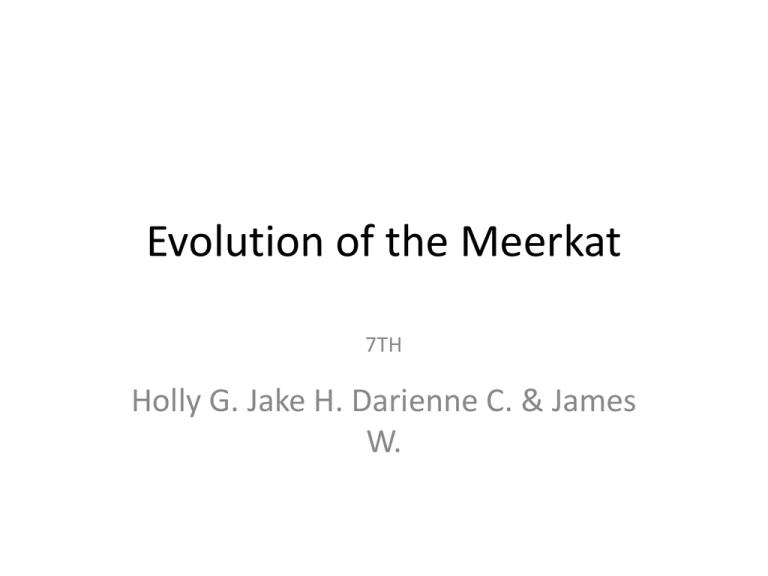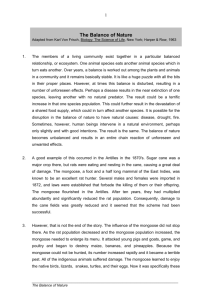evolution of the meerkat
advertisement

Evolution of the Meerkat 7TH Holly G. Jake H. Darienne C. & James W. Zoology • • • Belongs to the mongoose family, in close relation to the Ground squirrel, Yellow mongoose, Prairie dogs, Marsh mongoose, Kusimanse, Slender mongoose, Dwarf mongoose, Indian gray mongoose, White tailed mongoose, Banded mongoose, and Madagascar mongoose The Meerkat is a small mammal, weighing about 2 Ibs. They are about 25 to 30 inches long in the body and 15 to 25 inches in tail length. With a tail that is not bushy like most other mammals in their family. The meerkat has strong claws for digging burrows and digging for prey. Meerkats have evolved to their body features making it easier for them to evade predators using agility and speed, shape allows them to hide easily, their limbs are designed for navigating tunnels, not so much for making them -they can stand on their hind legs for maximum height when scouting for predators, their tail is used for balance -they live in the plains, so being able to climb is useless, that is why they are adapted for moving on or under the ground to avoid becoming lunch -the purpose of evolution is to allow an animal to adapt to their surroundings to survive from predators. Not only do they need to survive, but they need to do it better or differently than anything else in the ecosystem therefore the meerkat niche is: being small, quick, and living in tunnels simply because nothing else does the same thing, and since they don't need to compete, it is easier to live. Anatomist Contribution The Meerkat is said to evolved from the southern tip of Africa or Cape of Good Hope evolved from the Banded Mongoose. Banded Mongoose Meerkat Paleontologist Contribution Ida was discovered in the 1980s in a fossil treasure-trove called Messel Pit, near Darmstadt in Germany. For much of the intervening period, it has been in a private collection. The investigation of the fossil's significance was led by Jorn Hurum of the Natural History Museum in Oslo, Norway. He said the fossil creature was "the closest thing we can get to a direct ancestor" and described the discovery as "a dream come true". The female animal lived during an epoch in Earth history known as the Eocene, which was crucial for the development of early primates - and at first glance, Ida resembles a lemur. But the creature lacks primitive features such as a so-called "toothcomb", a specialised feature in which the lower incisor and canine teeth are elongated, crowded together and projecting forward. She also lacks a special claw used for grooming Molecular Biology • All of the Herpestidae family are small animals not growing above 1 foot. Most of the family have same diet of small insects. • Banded mongooses are a highly social mongoose and are closely related to the better known Meerkat. The Meerkat and the Banded mongoose both look similar in their appearance of body shapes, sizes, and features. They both have the same diets, and also engage in similar activities.











